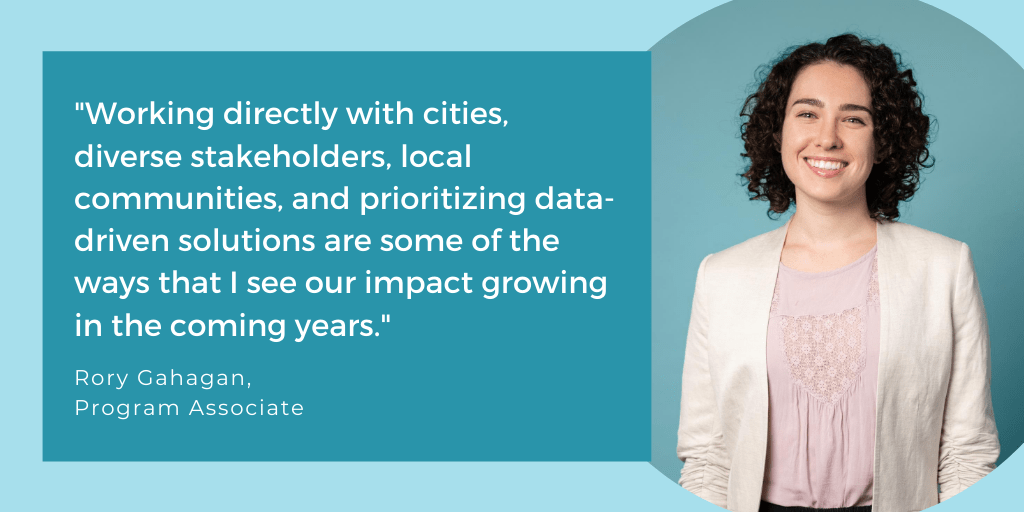IMT helps cities enjoy the economic, environmental, and social benefits of high-performing buildings through building performance policies that create healthy and resilient communities. Collaborating with building owners, tenants, governments, and other city and corporate stakeholders, as well as NGOs and strategic partners, IMT’s expert staff strive to catalyze collective and permanent market change in the built environment. So, who is IMT? Get to know our staff in this blog series.
In this Q&A, Rory Gahagan, IMT’s Program Associate, shares her excitement for helping IMT connect the dots between building performance policies, real estate, and local communities.

Was there a defining moment when the reality of climate change became personal to you? How does your current work at IMT address some of these climate challenges?
Growing up in North Carolina, I had many opportunities to play outdoors, particularly when I was at the beach. One summer, a couple of friends and I walked down to the Neuse River shoreline where we saw a caution sign posted at the stairs leading down to the beach. Once we got to the sand, we saw several fish washed up on the beach, and others dead in the water. Many of these fish had visible ulcers. It saddened me, and it turned my stomach to see and smell the rotting fish with open sores along the water where we swam and sailed. It’s safe to say that we didn’t go in the water that day, and the image stayed in my mind beyond that summer.
While fish kills can result from natural events, the gaping sores and surrounding warning signs suggested the cause to be something more insidious and man-made. I later learned that fish kills can occur as a result of low oxygen levels (from algal blooms or rising water temperatures) or toxic compounds in the water. They can also be a result of declining water quality and stressed river ecosystems. The fish kill I encountered and the ones that continue to plague coastal North Carolina are the result of pollutants, industrialization, and increasing temperatures, all of which fall under the big umbrella of climate change.
Energy efficiency might seem unrelated to fish kills, but I know that my work is contributing to both cleaner land and sea by supporting high-performing buildings and a decarbonized energy future. As a program associate at IMT, I work across the organization’s projects to support building energy policies, energy and policy concept research, private sector engagement, and data analysis and management. At IMT and beyond, any small action to decrease our carbon footprint helps building occupants and river fish alike live in healthier, more comfortable environments.
Why is diversity so important to IMT and the impact of our broader work?
Diversity is important because everyone should be included in the shift to greener forms of energy and enjoy the benefits of a cleaner future, not just the few groups of people who have dominated the leadership of the environment and energy fields for so long. If we’re not fighting for equity in our policies and actions, we’re not the progressive organization that we strive to be. White men have historically comprised the energy and environment space, so intentionally including people of color, women, non-binary folks, and people at the intersection of these identities in the decision-making process is one way to carve a more inclusive space and fight climate change.
IMT has always worked with cities to tailor their policies to local needs, but we need to be even more deliberate about including voices from populations who might not typically participate in policy making, but who would be effected by the end results of the policies. Resources from groups like All-In Cities and Emerald Cities Collaborative, as well as the NAACP, have helped us steer cities in the direction towards better, more inclusive energy workforce practices and policy design. Additionally, partnership with Kapwa Consulting has helped the policy team learn from guided conversations how equity and diversity issues have played a role in city-level building and energy policies. Going forward, seeking out community perspectives will allow IMT as a national organization to meet local community priorities.
As a program associate at IMT, what are some projects that you’re excited about leading or being a part of this year? What fresh perspective do you bring to IMT?
I’m excited to help IMT connect the dots between the policies we’ve supported, real estate, and the local communities we’ve ultimately affected. I think one way to start this work is bridging datasets and understanding policy impact through multiple perspectives. For example, a building performance policy might push large commercial building owners to make quick energy efficiency upgrades, but what is the impact on local affordable housing? Can these building owners keep up with the demands of compliance? Or, how do we help small businesses with less capital also enjoy economic, energy-efficient building improvements? I hope that we can imbue a holistic approach between buildings and communities into IMT’s recommended actions.
Continuing to support policy development and implementation within cities has been a key facet of IMT’s work. One of the projects I’m on is a Collective Action Group for city sustainability departments interested in either building audits or tune-up policy. This direct communication with cities offers resources and guidance on common pain points of building energy policy passage and implementation. It’s also inspiring to talk to the folks who directly work to reduce carbon emissions;their passion and on-the-ground work ultimately drives the change we want to see: a better built environment.
Where do you see IMT making the biggest impact in the upcoming years?
I think IMT will have a significant role to play in the movement towards decarbonization. Full decarbonization will require an economy-wide effort and holistic, multi-faceted thinking, like the kind we aim to do at IMT. We’ve focused on innovative ideas related to energy and buildings, like grid flexibility, building performance standards, and green leases, which are all implemented to varying degrees. Again, working directly with cities, diverse stakeholders, local communities, and prioritizing data-driven solutions are some of the ways that I see our impact growing in the coming years.
What has COVID-19 or the ongoing social justice movements revealed to you about the building efficiency sector? What would you like to see change?
As far as COVID-19 goes, the commercial real estate market has undoubtedly faced pressure from the massive shift to work-from-home. While remote work can definitely change employees’ lives for the better through increased flexibility, decreased commutes, and overall cost savings, it’s hard to say what exactly will happen to commercial real estate as a result of this working shift. Will it shrink due to less demand, will it expand to accommodate for social distancing, and/or will it completely transform to serve multiple needs? We’ve seen some buildings completely change their purpose to aid in the pandemic response, as parking garages and hotels convert to house additional hospital beds. While many of these changes are temporary, it’s possible some will become long-term. Ultimately, COVID-19 has shown me that buildings, much like individual workers, need to be nimble to succeed and to be useful to the society and the economy in which they exist.
The pandemic and the current social justice movement also intersect: there have been multiple reports which show infection and death rates to be disproportionately higher in BIPOC communities, while at the same time, important preexisting health infrastructure has been lacking in those exact same populations for decades, highlighting that the healthcare field has been and continues to be racist. However, pervasive racism is not exclusive to healthcare, and the field of environmentalism is also complicit. I think the most immediate connection between energy efficiency and the current movement for racial justice, then, is continued commitment to equitable work, even beyond diverse hiring practices. I’m grateful to be at a place like IMT that encourages self-examination and looks for ways that we can build a greener and more inclusive world. For myself, as a white woman working in the energy, green buildings, and policy fields, that commitment also means personally doing the work to practice anti-racism and not shying from hard conversations about racism in the sectors I’m a part of. As I make a shift in the way that I think and act as an individual, I know that at IMT, we will continue to work together to become better as an organization.
